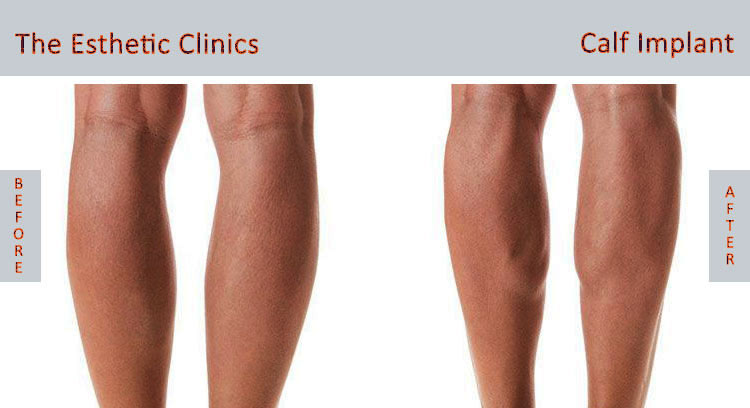Calf Augmentation – An Overview
A calf augmentation procedure is a purely cosmetic surgical procedure which is used to alter, or enhance the size and shape of the calves by placing soft silicone implants over the existing gastrocnemius muscles.
Patients seek calf implant procedure to give a more defined and toned look to the calf that cannot be achieved with exercise alone, as well as to correct a muscle imbalance resulting from a congenital (birth) or physical defect.
Candidates for Calf Augmentation
These are the more common reasons why a calf augmentation with implant might be required:
- To emphasize the bulkiness of the calf muscles (mostly men)
- Alter the lower leg to be more proportionate to the upper leg (mostly women)
- The plateau for the development of the calf muscles have been reached through natural exercises but the results are not satisfying (mostly bodybuilders)
- To correct lower leg abnormalities resulting from injury, disorder (club foot, spine bifida, etc) or a disease (polio, etc)
Any person who is in overall good health and wishes to make alterations to their calves can opt to undergo a calf augmentation procedure using implants.
Calf Augmentation Procedure
The calf augmentation with implants is a cosmetic surgical procedure and is a major form of orthopedic surgery . Prior to the surgery the surgeon/doctor will measure the legs to determine the right size for the implant to be ordered for the surgery.
This is a major surgical procedure hence the surgeon will administer general anesthesia to the patient in order to avoid pain or discomfort to the patient during the surgical procedure. The surgeon will then make an incision at the back of the knee and the surgeon will shift aside the skin, fascia and the gastrocnemius muscles. The surgeon will then locate the tibial nerve (salient nerve) in order to avoid damaging it and carefully push it shift it aside as well.
The surgeon will next carve a pocket (implant-sized) between the fascia (connective tissue sheet) and the muscles. This pocket is then fixed with the required calf implant prosthetic. After determining that the implant is properly fixed the surgeon will then use fine sutures to close the incisions and leave minimal scarring.
Types of Calf Implants
Calf implants are available in various materials such as silicone gel and solid silicone. Silicone-gel implants can often cause capsular contracture which results in the shrinking and tightening of the scar tissue around the implant causing pain, unnatural firmness, and distortion, however, this rarely occurs in calf implants.
Solid silicone implants can leave a palpable edge when placed too close to the surface. Silicone-gel calf implants are available in symmetrical sizes, which are suited best for the general population, and anatomical, which are best used for bodybuilders who desire more dramatic volume than the average-build patient.
The surgeon can also make custom-carved solid silicone implants before inserting. Depending on the individual need and desire, one or two implants may be inserted in each leg. Body fat is not an option for this procedure, as it is better used for augmenting smaller areas of the body, and because it gets absorbed by the body as well.
Implant Placement
The implants can be placed either sub-fascially (just beneath the fascia) or sub-muscularly (within the muscle).
Sub-fascial placement is used more frequently because the procedure is less invasive, less difficult, and leads to a faster, less painful recovery for the patient. However, sub-fascial placement can sometimes result in implant rotation and a palpable implant, and the postoperative appearance can be less than desired, because the calf shape is defined more by the implant and less by the muscle tissue. This can occur using either silicone-gel or solid silicone implants. Lastly, sub-fascial placement requires more attention to implant placement.
Sub-muscular placement is considered more difficult because your surgeon must dissect deeper into muscle tissue. You can also expect a few extra days of recovery and greater discomfort. However, the implant is more securely and accurately placed within the muscle and results in a better aesthetic outcome, including a more natural shape because the calf muscles cover the implant.
Pros and Cons of Calf Augmentation Procedure
These are the pros and advantages that a calf augmentation with implants procedure has over other procedures:
- Reshapes and enhances the calf muscles as required in a single procedure
- Easier and faster procedure
- Helpful in adding more mass and definition to the calf muscles mostly required by health enthusiasts (especially bodybuilders)
These are a few cons and drawbacks that might be experienced after a calf augmentation procedure:
- Swelling and discomfort in the lower leg right after the procedure
- Complete recovery may take around 4-6 weeks for resuming physical activities
- Complete results may take a few months to show
Choose HealthYatra for Affordable and Efficient Calf Augmentation procedure in India
HealthYatra is the leader in medical tour service providing in India. It is connected to a vast network of healthcare facilities that are spread across all major Indian cities. These are multi-specialty hospitals and clinics that are equipped with the most advanced and high-tech devices and medical instruments. HealthYatra offers each individual patient a bespoke treatment package that provides the most efficient and affordable calf augmentation surgery procedure in India.
TAGS: Affordable and Efficient Calf Augmentation in India, Calf Implants Surgery Cost in India, calf implants cost in india, calf implants meaning, calf implants female
For More Information Call on : +91 7387617343 Email : [email protected] Direct Contact on Whatsapp : +91 7387617343
[contact-form-7 id=”536″ title=”Contact form 1″]

